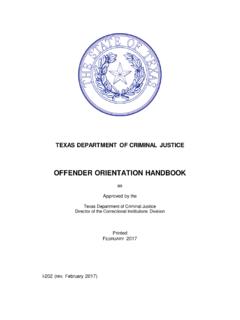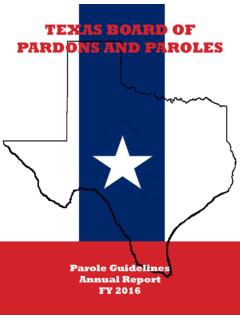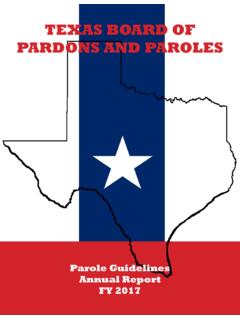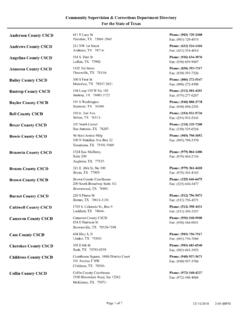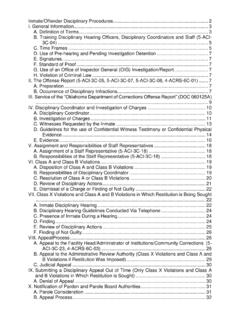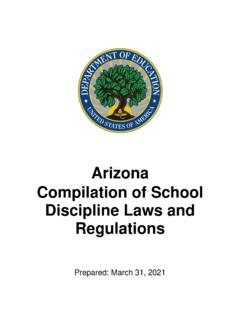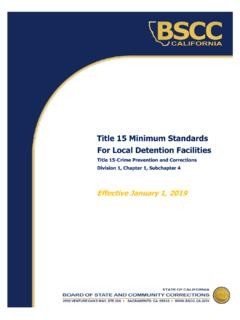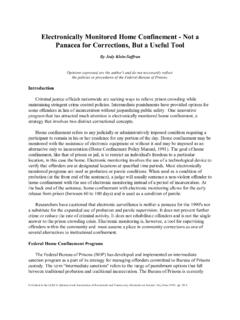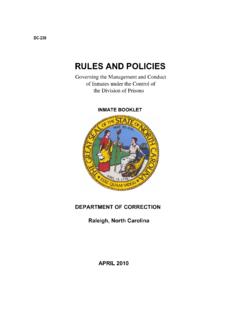Transcription of LISTING OF EMPLOYEE GENERAL RULES OF CONDUCT AND ...
1 (11/21) LISTING OF EMPLOYEE GENERAL RULES OF CONDUCT and disciplinary violations These RULES specify the CONDUCT required of a TDCJ EMPLOYEE . DEFINITIONS: The following definitions apply solely to the rule violations . Conviction is: (a) a finding of guilt by judge or jury and the assessment of punishment, whether confinement or fines; (b) community supervision (probation), including deferred adjudication; (c) a juvenile adjudication of delinquent CONDUCT if the juvenile records are not sealed; and (d) an equivalent disposition of an offense under the laws of another state, federal law, or Uniform Code of Military Justice. The term does not include a pretrial diversion, which is an agreement between the defendant and prosecutor and occurs before a judicial finding, although a judge may approve of the defendant participating in the program.
2 Pardons or reprieves do not eliminate a conviction. Discourteous CONDUCT of a Sexual Nature is CONDUCT , in words or actions, of a sexual nature toward or witnessed by another TDCJ EMPLOYEE or other individual (see definition for Other Individual ) that: (a) a reasonable person would find offensive; or (b) is unwelcome to the person to whom such CONDUCT is directed and that person has communicated, by words or actions, to the other person that the CONDUCT is unwelcome. Discrimination is unequal treatment of persons based on a protected class, including sexual harassment. Discrimination by employers falls into four GENERAL areas: (1) hiring and firing, such as failing or refusing to hire, or discharging; (2) employment conditions, such as compensation, terms, conditions, or privileges; (3) segregation and classification, such as limiting, segregating, or classifying employees in any way that would deprive or tend to deprive any individual of employment opportunities or otherwise adversely affect their status as an EMPLOYEE ; and (4) training, such as unequal access to training that may affect an individual s ability to promote.
3 EMPLOYEE is any person employed by the TDCJ on a full-time, part-time, or temporary basis. Harassment is systematic or continued unwanted actions, including threats and demands, directed toward an EMPLOYEE or other individual that may create a hostile work environment for the person to whom the acts are directed. Hazing is CONDUCT that intentionally subjects another person to embarrassment, intimidation, or ridicule and risks emotional and/or physical harm. Horseplay is rough or boisterous CONDUCT by an EMPLOYEE for the purpose of amusement, such as running, wrestling, or offensive practical jokes. (11/21) Hostile Work Environment is offensive behavior that is severe or pervasive enough to alter the victim s employment conditions and create an abusive working environment.
4 All the circumstances shall be considered, including the frequency of the CONDUCT , the severity, whether it is physically threatening or humiliating, or a mere offensive utterance, and whether it unreasonably interferes with an EMPLOYEE s work performance. Isolated instances, unless extremely serious, will not amount to discriminatory changes in the terms and conditions of employment. Marriage includes ceremonial marriage and informal marriage, which are the two types of marriage recognized by the state of Texas and are defined as follows: a. Ceremonial Marriage is a marriage documented by: (1) a marriage license recorded with a county clerk; and (2) a marriage certificate issued by the county clerk.
5 B. Informal Marriage, previously known as common law, is a marriage that is not necessarily documented through a county clerk, but is valid when a couple agree to be married and after that agreement live together in the state of Texas as a married couple and represent to others that they are married. Offender is an individual under the supervision or custody of the TDCJ, including a TDCJ offender housed in privately operated, federal, county, or other states facilities. These individuals include, but are not limited to, parolees, individuals under mandatory supervision, incarcerated individuals, and individuals housed in county jails that have been sentenced to the TDCJ but are not yet in TDCJ custody.
6 Other Individual, for the purpose of Rule Number 5, includes, but is not limited to, a contract EMPLOYEE , applicant, EMPLOYEE of a vendor, intern, or volunteer. For the purpose of Rule Numbers 21, 50, and 53, the definition includes, but is not limited to, a contract EMPLOYEE , applicant, EMPLOYEE of a vendor, intern, or volunteer who reports or is a victim of sexual harassment, discrimination, or discourteous CONDUCT of a sexual nature. This definition does not include an individual under the supervision or custody of the TDCJ. Property is anything owned or leased by the state, such as equipment, land, motor vehicles, or structures.
7 Protected Class is a group of people with a common characteristic who are legally protected from discrimination on the basis of that characteristic. In the GENERAL context of equal employment opportunity, the protected classes are race, color, religion, sex (gender), national origin, age, disability, and genetic information. Retaliation is: (1) any action that may deter a reasonable person from filing a complaint, participating in a proceeding regarding, or otherwise opposing an alleged EEO rule violation; or (2) any action against an applicant, EMPLOYEE , or other individual because of that person s association with an individual who has engaged in a protected activity.
8 For Rule Number 22, retaliation is any adverse action taken against a person for any reason not supported by TDCJ policy. (11/21) Serious Injury or Serious Bodily Injury is bodily damage that creates substantial risk of death or that causes death, permanent disfigurement, or protracted loss or impairment of the function of any bodily member or organ. Sexual Harassment is unwelcome sexual advances, requests for sexual favors, or other verbal or physical CONDUCT of a sexual nature when: (a) the CONDUCT is sufficiently pervasive or severe that it has the effect of unreasonably interfering with an individual s work performance or creating a work environment that a reasonable person would find intimidating, hostile, or offensive; (b) submission to the CONDUCT is made either explicitly or implicitly a term or condition of an individual s employment.
9 Or (c) submission to or rejection of the CONDUCT by an individual is used as a basis for employment decisions affecting the individual. Spouse means a person to whom a person is legally married. Use of Force is a controlling measure taken during a confrontational situation to achieve the compliance of an offender or to maintain a safe and secure environment for offenders and staff. Deadly Force is force intended or known by the actor to cause, or in the manner of its use or intended use is capable of causing, death or serious bodily injury. Excessive Force is the use of more force than is objectively reasonable to accomplish a lawful purpose.
10 Non-Provoked Use of Force is force used absent an action by an offender involving physical assault, attempts at physical harm, an escape attempt, mutiny, rebellion, or serious damage to property. Provoked Use of Force is force used in response to an action by an offender, such as a physical assault or an attempt to physically harm oneself or another, that is necessary to prevent an escape, regain control of an institution, temporarily isolate or confine an offender, prevent serious damage to property, or gain compliance with a legal order or policy for which some degree of force is required to defuse the situation. Throwing of liquids, spitting, and other such actions may be considered a provoked use of force situation depending on the circumstances.

